Some call it a hobby, some an obsession, and some simply an art. But what makes photography an art? Why do people become passionate about it? Photography is such an easy hobby to get into.
Anyone can buy a camera and start snapping away. Still, not everyone enjoys taking pictures as much as the next person does. For those who don’t take photos often, photography can seem less like an art and more like a hobby. Fortunately, that doesn’t mean there aren’t plenty of ways to make your photo-taking hobby more rewarding and less of a chore.

Exposure control
Eyes aren’t always the best judge of how much light is available. To avoid underexposing an image or overexposing it, you need to know how to set your camera’s exposure settings correctly. Knowing how to adjust your camera’s settings for different types of lighting and situations will give you more control over your images. You can also use your knowledge of exposure to creatively alter an image.
For example, an image of a green piece of paper under a bright blue sky may look nice and blue, but if you know that the paper is yellow and that there’s also yellow sunlight behind it, you can compensate by dialing down the exposure until you’re around 50% grey. This will give the paper the same amount of yellow as the paper would have if it were in the sun.
Depth of field control
Have you ever been in a completely crowded place, with tons of people and only a small area where your subject is present? It’s frustrating to have your photo ruined by the distracting backgrounds and people in the shot.
You can control how much of the background shows up in your photo by adjusting the aperture setting on your camera. Low apertures like f/32 will let in a lot of light, while larger apertures, like f/1.4, let in less light, creating a more bokeh-like background blur. Bokeh is the artistic term for the dreamy background blur that photographers often strive for.
Composition control
Composition is like putting the right ingredients together to create a delicious dish. In photography, you’re creating a dish, not just putting ingredients together randomly. For example, you may want to take a photo of a delicious, but small, piece of cake with a vast, broad desert as the background.
The solution? Hold the cake in front of the desert, so that only its edges and the background are visible. You can control how much of the surrounding elements are included in your image by changing the composition. You can also change the composition mid-shot so that your photo is an entirely different view than it would have been if you’d stayed in the original position.
Skill-based creativity

Anyone can take a photograph, but manipulating the image in some way, to create a new end product such as a painting, drawing, sculpture, etc. is what makes photography an art. This is often referred to as skill-based creativity.
There are many ways to create an artistic work out of photography. You can edit your photos in many different ways, create montages, use filters, and other special effects, or take portraits that creatively alter the image.
Collecting is an art!
It may sound absurd, but it’s true. Artistic Photography is more than simply taking photos. It’s an art form, and like any art form, it involves an element of collecting items that inspire you. You can collect anything that’s appealing to you, whether it’s a particular type of object, a certain theme, or just one specific object. The key is to keep collecting things that inspire you and that you find interesting so that your collection doesn’t get stale or boring.
Conclusion
While some would argue that photography is just a hobby, there are still those who call it art. The elements of skill, exposure, and composition are what make photography an art. And like any other art form, there are also collecting items that photographers might find interesting. Photography is more than just taking photos. It’s an art form that involves collecting items that inspire you. Thus, photography is an art!

















